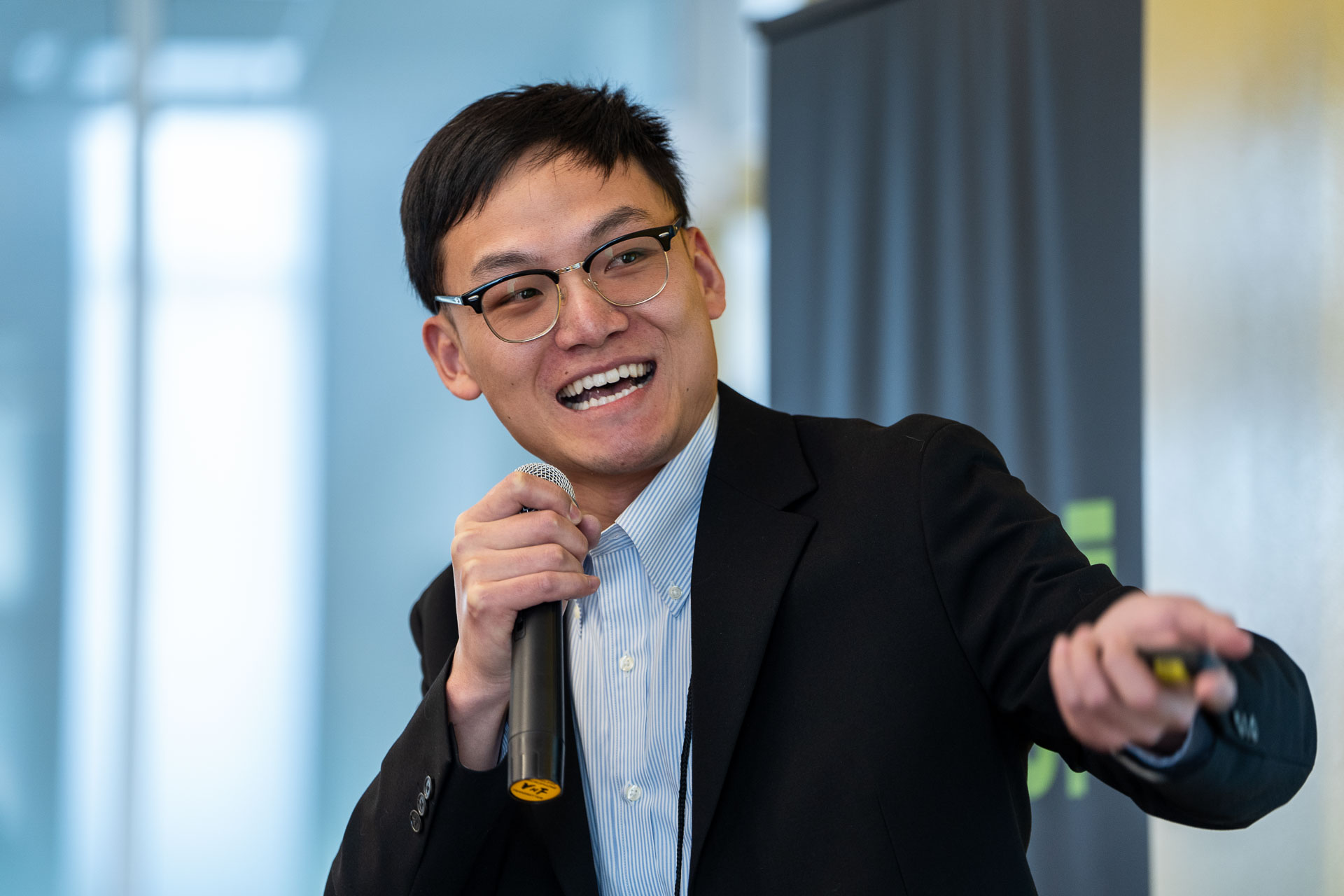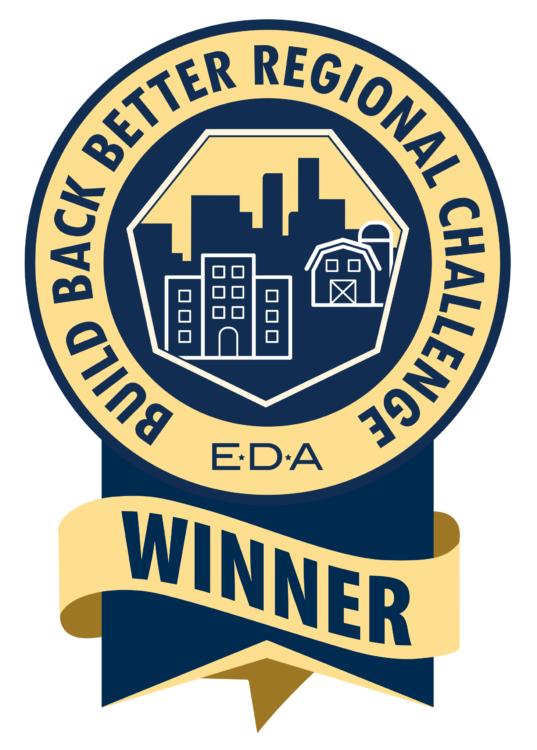
ChargeUp Accelerator’s inaugural cohort continues to collaborate six months after graduation
By Katie Liu, June 3, 2025
Andrew Wang, co-founder of battery startup Standard Potential, stood at a demonstration booth to show his company’s developing sodium-ion technology to conference-goers. Across from him was a booth for battery company Fermi Energy, where Wang struck up a conversation with its CEO Ray Xu.
But they weren’t strangers. Wang and Xu had met earlier, through New Energy New York’s (NENY) ChargeUp Accelerator, where they spent six months in and out of Binghamton studying an intensive curriculum aimed at supporting and pushing their companies into investment-ready shape.
Half a year after they graduated as part of ChargeUp’s inaugural cohort, Xu and Wang, like their fellow group members, keep in touch. As they land more customers and seek out more feedback, those customers include one another too.
“We’ve been able to benchmark each other’s technologies and see how we can best work together,” Wang said. “There has been actual exchange of goods and services between the companies.”
ChargeUp Accelerator is the only program in the U.S. to focus solely on battery companies, taking advantage of infrastructure and resources in the upstate New York region to mentor and nurture startups at different stages in their journeys.
Four companies were selected to be part of the program’s first cohort: Standard Potential, Fermi Energy, Ateios Systems and MITO Materials.
Each company entered the program with different goals. Standard Potential, which aims to use the earth-abundant mineral sodium in its batteries to speed up the clean energy shift, came in looking for a direction to take its technology, Wang said.
“We went through a lot of customer discovery and other product-market fit programming and exercises that ChargeUp was able to connect us through,” he said. “I think through that process, we’ve been able to iterate and find a direction on product development that’s more toward how we’re using batteries and enabling new applications where energy storage can be deployed.”
Similarly, Ateios Systems sought out the confidence that it was hitting all the right markets and narratives through ChargeUp, according to CEO Rajan Kumar. Ateios Systems is pioneering a light-curing method to create electrodes, eliminating the use of toxic forever chemicals in the battery-making process.
“The biggest thing is maybe not the lessons, but the affirmations,” Kumar said. “We had a lot of questions that we were asking ourselves in March and April when we joined the program. I think the ChargeUp program gave us a lot of confidence or affirmation that this was the right way to go.”
Those affirmations encouraged Ateios to focus on the components and processes it was best at, rather than targeting cell manufacture as a whole. This, Kumar said, ultimately made for better storytelling and marketing, pulling in even more attention and funding.
Solidifying the belief that Ateios was following the right pathway, ChargeUp additionally helped
Kumar’s business come up with a core marketing plan. Something as seemingly simple as a consistent name — “RaiCore” for its electrodes or “RaiCure” for its curing method — has allowed Ateios to remain nimble in its branding and product portfolio.
“What if a new chemistry comes up? How do we market that name and still be consistent with that we’re doing today?” Kumar said. “[ChargeUp] gave us a marketing plan that we could use today and in the future — which is priceless.”
Six months out now, several months after finishing the program, both Ateios and Fermi Energy are busy with new projects, including an R&D grant from the NSF Energy Storage Engine in Upstate New York, another federal Binghamton University-led initiative supporting battery development in the region.
The grant, said Kumar, will allow Ateios to continue refining its new products to improve capacity retention rates. The company was also recently announced as a first-round pick out of nearly 1,000 applicants in the inaugural TitletownTech Startup Draft, earning $1 million in investment as well as $350,000 in Microsoft Azure credits.
“Many startup CEOs dream of ringing the bell on the NYSE, but we had an excellent opportunity to take the main stage at the NFL Draft,” Kumar said.
Meanwhile, Fermi Energy is also juggling a project funded by the Department of Energy related to sodium-ion batteries. Through its R&D grant under the NSF Engine, it will collaborate with a research team led by Hao Liu, an assistant professor of chemistry at Binghamton University, to develop new manufacturing technology for its manganese-rich cathode powder.
Finally, Standard Potential is expanding its laboratory capabilities and spaces, on top of its core team. Wang said it has received additional support through NENY’s Technical Assistance program to conduct safety testing at the Rochester Institute of Technology and product development with the New York State Energy Research and Development Authority.
With all these projects in store, Wang’s company is aiming to dive into private fundraising this year. “We’re getting to the point where we’re seeing early signs of market adoption of the various products that we’re developing,” he said.
Ateios has sold about 10 sample packs of its RaiCore electrode to a range of customers and has landed collaborations with larger companies such as Kodak. Though historically known for its film photography, Kodak is lending its capabilities in thin-film coating to Ateios.
“We’re trying to shift our production from Indiana to New York now, because all the customers, supply chain and manufacturing partners are in New York,” Kumar said. “We’re seeing a real pull to move to New York, because it’s built a really robust ecosystem.”
Looking forward, Fermi Energy continues to raise money and scale up. It has also set eyes on
New York for its next move. “We will be relocating away from Blacksburg, Virginia, probably this fall or the end of the year, so we are trying to identify a new place for our next home. That will probably be in New York state,” Xu said. Fermi Energy has since applied to become a member company at the Koffman Southern Tier Incubator in Binghamton, with plans to continue ramping up its presence in the region.
Venturing together
As these companies trek onward, embarking on ventures together may also be on the docket.MITO Materials, for example, specializes in additive graphene, and Kumar imagines it could supplement Ateios products with said mineral. He also sees the possibility of Ateios using Standard Potential’s and Fermi Energy’s materials to supply electrodes as they look to scale.
“We’re a customer, where we could buy materials from them and get in the marketplace,” Kumar said. “Or, if they want some coating help, we can help them as well. There’s really good synergy between the four groups in terms of that.”
Even more convenient is the fact that ChargeUp’s initial core four occupy different stages of the battery production chain. Wang explained that downstream companies like his own assemble batteries into the final product consumers use, while upstream companies such as Fermi Energy innovate the components that go into cells.
“We actually had a conversation about applying for grants together,” Xu said, referring to potential collaborations with Ateios. “Basically, we’re trying to identify a good opportunity to work together in the future.”
Now, ChargeUp Accelerator has kicked off its second year and second cohort, this time with seven battery startups. Xu offers in terms of advice, “Just try to be a blank paper. Everyone comes to the cohort with some knowledge already about the domain, but in the training process, I would say just consider yourself as a newbie in the market and try to learn as much as possible.”
Wang shared similar sentiments, adding, “We really benefited from coming in as an earlier-stage company. We had other companies in our cohort that had already raised funds or had a good set of paying customers. Trying to pick their brain on that was really great.”
The broader industry landscape may be in flux at the moment, but uncertainty doesn’t stop leaders and entrepreneurs from looking ahead with optimism. New York State, Xu said, is a particularly good place for battery startups to find support and resources.
“We are not really competing with other battery companies,” he said. “We’re competing more with fossil fuels.”
After six months together and six more months chasing after their own projects, these ChargeUp graduates are even more ready to take on the clean energy challenge — and bring one another along at the same time.
“It’s a good combination of the different companies, because we’re not competitors to each other,” Xu said. “We’re supporting each other in the cohort.”
.





